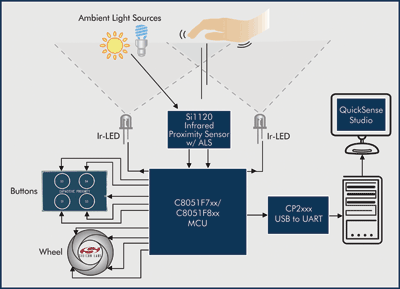The continuing evolution of the human interface
MCUs and inexpensive sensors provide great ways to communicate
BY MIKE SALAS
Silicon Laboratories
Austin, TX
http://www.silabs.com
The phrase “human interface” has long been part of the technology industry lexicon. With advances in touch sensors, proximity sensors, ambient light sensors, and accelerometers, the ability and sophistication of devices used for inputs have dramatically changed. Figure 1 shows how a simplified human interface process flow can be envisioned.

Fig. 1. Simplified human interface process flow.
Each of the input events is tied to a specific threshold level that must be met to trigger one or more output events. Similarly, each output event is tied to one or more subsystems that will be affected.
For example, a handset device may be kept in a sleep-mode for power-saving reasons. However, upon the detection of a touch that exceeds a certain pressure threshold, the handset will turn on the screen, provide an auditory confirmation over a speaker and turn off the screen locking feature. A single input event has been tied to three different output events affecting two different subsystems.
The good news for designers is that innovation has dramatically improved the ability of a device to offer a wide variety of creative input and output choices that can add a significant amount of appeal to an end product. However, this rapidly improving capability comes at a price: design complexity. From an implementation perspective, what is really needed is the ability to create an interconnected framework that enables a tight coupling of these input/output interactions while still leaving flexibility to adjust for ever-changing market requirements.
One possible solution is to have a range of sensing elements closely tied to a flexible, software-configurable platform. An example of this type of human interface subsystem appears in Fig. 2 .

Fig. 2. A human interface subsystem.
An example system design
To analyze how a human interface subsystem could be used to create an effective platform, let’s examine a proximity sensor. A single proximity sensor could be used to detect the presence (or absence) of an object, such as a hand or the user’s body.
Proximity sensors yield the distance of an object through an infrared reflectivity system. A computer monitor can use an embedded proximity detector to detect the presence of the user.
If the user is not present, it can shut off the screen to save power and turn it back on when the user has returns. Capable of detecting proximity at 50 cm unaided, the latest proximity sensors, when coupled with high-performance MCUs, can provide the ability to detect motion and interpret gestures, background light levels, and background light types.
This capability refers to the ability of a system to look specifically for the motion of an object to perform a specific action. For example, a handset application may allow a user to page through a document simply by waving a hand over the handset.
By adding a second proximity sensor to the design, this type of one-dimensional motion capability can be enabled. Through customized firmware, these two proximity sensors can be designed to interact very closely with the MCU to provide both the presence of motion and the direction.
Similarly, for more complex two-dimensional motions across both the x and y axes, a third proximity sensor can be added. The MCU can then be used to interpret the information to determine the exact movement occurring across the face of the system. Users may not only want to turn pages of a document (x-axis hand wave motion), they may also want to pan down the page of the document (y-axis hand wave motion).
Other proximity applications
The low-power nature of the latest infrared sensors enables interesting new functions. For instance, tamper and intrusion detection with invisible infrared light provides a difficult to detect feature in products such as security boxes, smoke detector chambers, or casino gaming machines.
A security box typically might contain a mechanical switch on the interior for intrusion detection. The switch comes at a significant cost when wired and mounted to the door assembly. A simple infrared LED and proximity detector mounted on the interior can detect a change in reflectivity as the interior of the door moves away from the sensor. No extra wiring is required, and the feature is virtually undetectable.
As another example, a VoIP phone can be programmed to dim the LCD backlight when the user is away for a period of time. These are only two examples, and given the creativity and inventiveness of consumer electronics and industrial system engineers, there will be many, many more.
One of the hardest challenges that system designers face is envisioning what a compelling human interface solution will look like. By using a scalable architectural framework and the latest in infrared sensor technology, it is possible for system designers to add advanced human interface features to their products without the design tradeoffs they have faced in the past. ■
Advertisement
Learn more about Silicon Labs





